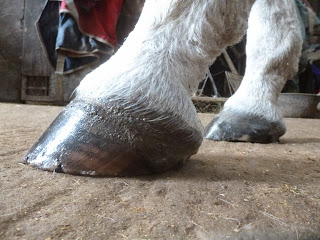Very often I read owners or vets describing hooves as if the problems the horse has with them are inevitable. "The hooves are [under-run, thin-soled, boxy, upright, turned-in, flat, brittle or whatever]" is said in rather the same way as "the horse is bay" or "the horse is a gelding" - thats just the way it is, he'll never change.
When describing hooves, people almost always leave out the critical caveat: "at the moment".
The point is that hooves are dynamic - no matter how they are "at the moment" they can be very different in 6 months time provided that you enable the changes the horse needs.
I rarely have the chance to show time-lapse photos of hooves over 6 months (roughly the time it takes for a horse here to grow a new hoof capsule) but Goofy has been here since November and its a perfect opportunity to show what I mean. First off, compare his stance on arrival (above) with how he stands today.
To me he is balanced and solid on his feet now - he looks confident that he knows where his feet are and that they are doing the job for him.
When he arrived he had been diagnosed with bilateral DDFT tears, worse on this, his LF. He'd had surgery and box rest and his lameness had improved but was still evident. His feet were far from the worst we've seen but they were fairly flat and the palmar hoof was weak, particularly the frog which had a central sulcus split.
Today he has a much more business-like foot. There is better concavity now that his new hoof capsule has fully grown in and old abscess damage, which he had on arrival, has also gone.
Again the biggest change is the much more robust palmar hoof - the frog is visibly tougher and the heels are less under-run.
The caudal shot gives the clearest indication of what has changed. If you look at the digital cushion in the photo below, when he arrived, the hairline is sloping inwards towards the frog; there is very little internal strength and this foot has a limited ability to shock-absorb.
Today the digital cushion is more developed and better able to provide support - instead of sloping the hairline is more level - not perfect but improved.
Looking at the LF the central sulcus split is obvious. This is the sort of problem which is extremely hard to get rid of - sometimes the best you can do is keep it clean and the infection at bay. This is usually enough to allow the horse to begin to land heel-first which in turn allows the frog to strengthen.
The split is still here but is not causing him ongoing problems - his landing is good and he is in consistent work - Goofy featured in the Road movie blog last month, for those of you who visit regularly.
Time lapse shots from the lateral side also show changes - not as dramatic as some we see but interesting nonetheless.
The most significant differences I think are the stronger digital cushion - more bulk above the hairline - and better hoof/pastern axis in the lower photo.
As with the first photos, its his stance which is the most improved here. A better digital cushion leads to a stronger palmar hoof and that in turn leads to a better hoof/pastern axis are clear too.
Overall its just a more supportive, more balanced foot which means he can load and use his front legs properly, meaning a sounder, happier horse.
Of course, good hooves are just as dynamic as poor hooves; no matter how you describe your own horse's hooves, don't forget to add "at the moment"...
























2 comments:
I love reading your blog. Highly informational!
Thank you Sarah :-)
Post a Comment